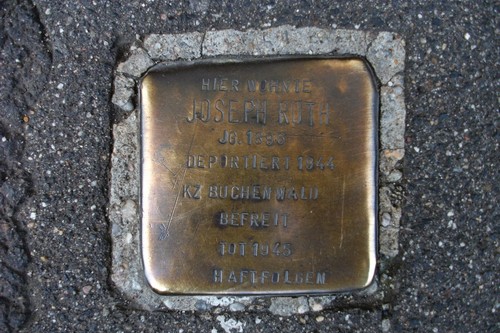Stumbling Stone Annaberger Straße 74
This memorial stone (so called Stolperstein or stumbling block) commemorates Joseph Roth, perished after the liberation of Buchenwald.
The small copper plaques, in the pavement in front of houses of which the (mostly Jewish) residents were murdered by the Nazis, mention the name, date of birth and place (mostly a concentration camp) and date of death.
In many other German cities the memorials also can be found. There are already many thousands of these plaques and their number is still counting. Almost all Stolpersteine are laid by the German artist himself, Gunter Demnig.
Joseph Roth, born 30 January 1896 in Cologne. His father, Wilhelm Roth (1870-1948), was a painter for churches and holy pictures. He became a teacher. In WW1, he was from 1914-1916 on the Westfront near NeuveChapelle, where he was wounded. After WW1 he got a job in Bonn-Bad Godesberg where he also found his future wife in Friesdorf. Beside his job as a teacher he was very interested in politics and so become to be a local high political position in the "Zentrum" Party. He was a enemy of the Nazis and lost his job and political work after 1933.
In 1944, after the operation "Walküre", the last attempt against Hitler, the Nazis took him into prison. A couple of weeks later they took him to the Concentration Camp Buchenwald. When he came into the Camp his weight was 120 kg. After 2 months in that prison, they let him go home, but gave him a poison injection which killed him slowly. His weight was at that time 48 kg. 3 months later he died with a lot of pain at home from that poison.
In 1956, the town Bad Godesberg named a street after him. In 2000 the Pope made him a martyr. In 2006 the artist Demnig placed this "Stolperstein" in front of his last home, where he died.
Do you have more information about this location? Inform us!
Source
- Text: Josef Roth & Fedor de Vries
- Photos: Josef Schugt
Nearby
Museum
Point of interest
- Otto Kühne School - Bonn
- Rheinhotel Dreesen - Bonn
- Windeck Air Raid Shelter Budapester Straße - Bonn
Monument
- Bismarck-tower Bonn-Gronau - Bonn-Gronau
- War Memorial Bonn - Bonn
- War Memorial Bonn Kessenich - Bonn Kessenich
Cemetery
- German War Graves Ippendorf - Ippendorf
- German War Graves Niederdollendorf - Niederdollendorf
- German War Graves Lengsdorf - Lengsdorf




